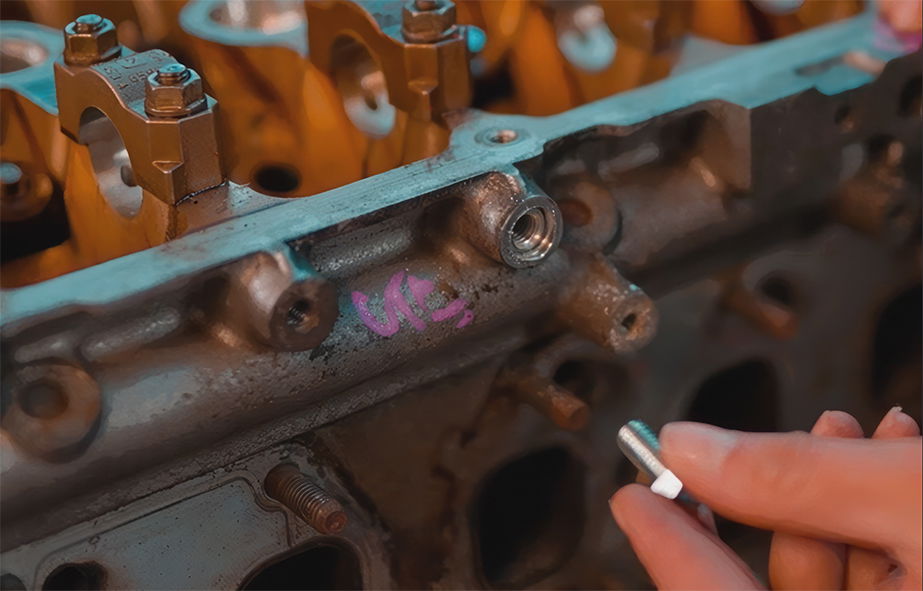
Repairing threads: Turn old into new - it's that easy
Sustainability and environmentally friendly work are currently hot topics. Often, it raises concerns that adapting one's work accordingly would be complicated, expensive, and cumbersome. However, sustainability is something that not only helps the environment but can also save you time and money. For example, by repairing worn or damaged components instead of replacing them. This approach can even be applied to threads.
Repairing threads may sound like a challenging task. With the necessary knowledge and the right tools, you can achieve this without much practice. Of course, at BAER, we are here to support you. We'll explain in detail how to best go about repairing threads.
Repairing Threads Can Be Done in Many Ways
You have several options when it comes to repairing threads. The best method for you depends on the type of damage or contamination. You can repair dirty, rusted, or slightly damaged threads by re-cutting them with a standard screw tap. However, there are also tools specifically designed for repairing threads, such as the Thread Restoration tool or the thread file.
Additionally, you can use thread inserts to repair or reinforce internal threads. This method not only restores the functionality of a thread but can also be used preventively to increase the tensile strength and durability of a thread. At BAER, we have developed two product lines, BaerCoil® and BaerFix® that make repairing damaged threads quick and easy!
Repairing Threads with BaerCoil® Wire Thread Inserts
Our BaerCoil® thread inserts for repairing threads are wire spirals with a diamond-shaped cross-section. These wire inserts can be easily installed in a damaged thread and enhance pull-out strength, surface quality, and protection against corrosion and wear. In addition to repairing threads, the BaerCoil® thread inserts can also be used to strengthen threads. In materials with low shear strength such as magnesium or aluminum, threads reinforced with BaerCoil® can withstand higher loads, allowing for smaller thread diameters and shorter thread lengths.
What You Need to Repair Threads with BaerCoil®
To repair a thread with BaerCoil®, you primarily need the suitable wire thread insert. These inserts come in various designs: "free-running" type for regular applications, "screw grip" type with polygonally shaped windings for a strong locking effect, and "NoTang" type without tangs for faster installation.
Before you can repair the thread using the inserts, you need to prepare it. For this, you'll require a drill bit, a countersink if necessary, and a suitable STI screw tap. For the actual thread repair, you will also need our BaerCoil® installation tools to install the wire insert. These tools are available in various versions for manual or machine use. Please note that the "NoTang" type requires a specific installation tool. A tang breaker is also useful for breaking the tangs on "free-running" and "screw grip" types.
How to Repair Threads with BaerCoil®
With the BaerCoil® product range, you can easily repair a thread in a few steps:
1. Drill out the damaged thread when using the wire thread inserts for thread repair. If you want to strengthen a new thread using the product, create a pilot hole, similar to thread drilling.
2. Cut the thread using a screw tap, or simply re-cut the existing thread when repairing the thread.
3. Place the BaerCoil® wire thread insert onto the installation tool. Choose the right tool: manual installation tool or machine installation tool. Screw it into the thread.
4. Remove the installation tool; the BaerCoil® wire thread insert is now securely seated in the thread.
5. Use a tang breaker to break the tang (except for "NoTang").
The thread repair is complete!
Repair Threads with Self-Tapping BaerFix® Thread Inserts
Another way to repair threads is to use our BaerFix® thread inserts. What sets these inserts apart is that they are self-tapping. When using BaerFix® for thread repair, you don't need to pre-drill the thread with a thread tap. This applies at least to materials up to approximately 400 N/mm². However, for hard, high-strength, and tough materials, you should prepare the receiving thread accordingly when repairing the thread.
What You Need to Repair Threads with BaerFix®
To strengthen or repair a thread, you can get BaerFix® thread inserts with cutting slots for lightly to moderately machinable materials, with cutting bores for lightly to heavily machinable materials, and with cutting bores for spark plug threads.
To prepare the receiving hole, you will need a drill bit and a countersink. Since the BaerFix® thread insert can cut its own thread in materials up to 400 N/mm², you won't need a screw tap for repairing threads. You can perform the installation using a manual installation tool or a machine installation tool.
How to Repair Threads with BaerFix®
To repair a thread with BaerFix®, you only need to follow 4 simple steps:
1. Drill out the damaged thread or create a pilot hole when using BaerFix® to strengthen a new thread.
2. Screw a thread insert onto a manual installation tool or a machine installation tool.
3. Insert the combination into the prepared hole while the thread insert creates its own receiving thread.
4. Remove the installation tool, leaving the insert in the thread.
Thread repair is now successfully completed!
For further information, all variations of our BaerCoil® and BaerFix® thread inserts, as well as all required tools such as thread taps, installation tools, and tang breaking tools, can be found in our BAER online shop! And if you have any questions about thread repair, don't hesitate to contact us as your thread tap manufacturer.
